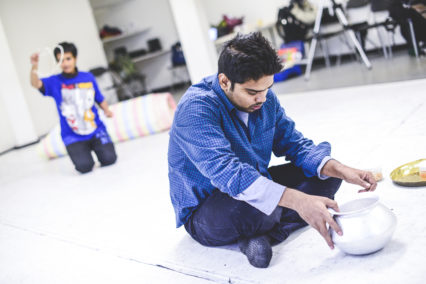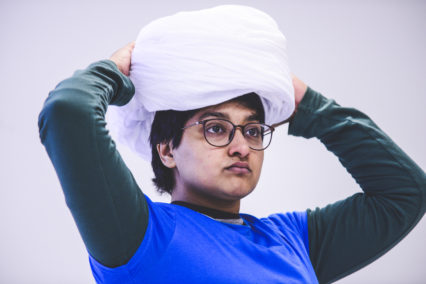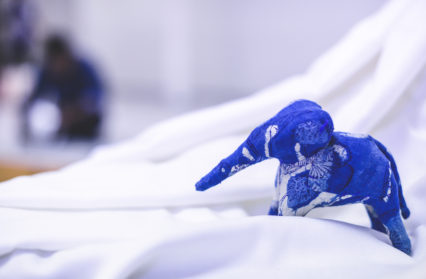Gary Raymond spends a few days experiencing the work of Theatr Iolo and ThinkArts of Kolkata during the Welsh leg of their Wales/India collaboration on developing theatre for 6-18 month old babies.
There is very little that is new under the sun, and when an artist looks for that original concept it is often easy to overlook one particular potential direction of travel – backwards. The idea of theatre for babies is not quite newborn – it seems to have seen a burst of energy in the last few years, namely in Belfast, where Anna Newell’s work for babies and toddler’s even caught the eye of the New Yorker a couple of years ago, whose Michael Schulman wrote about his peek into the world with a typical admiring cosmopolitan nonchalance. Despite a good write up there, and a blogspot in The Guardian, Newell’s innovative work didn’t quite mark the burgeoning of a phenomenon, however. Theatre for babies has not taken the world by storm, and there could be a reason for that: it’s difficult to get your head around without seeing it firsthand, and the audiences are, by its very nature, small.
In the last couple of years, as part of the UK/India year of culture programme, those enclaves have been increasing in Wales and India thanks mainly to innovative work of one Welsh company.
 Theatr Iolo are now old hands at creating work that pushes the boundaries for young people, and now artistic director Kevin Lewis and associate creative artist, the director Sarah Argent, are using the successes achieved with Out of the Blue, their first work for babies from a few years ago, to spread the gospel. Their collaboration with Kolkata’s ThinkArts has seen a great deal of fervent conversion. And indeed, the conversions to the very idea of theatre for babies are almost unadulterated in their wake. ThinkArts founder and director Ruchira Das talks absolutely with the passion of a convert. She has dedicated her life to providing access to the arts for under 18-year olds in her hometown of Kolkata, but theatre for babies is not only new to her, but as far as anybody can tell, it’s new to India. In 2017, Lewis and Argent took the concept out there, workshopped ideas, toured performances of Out of the Blue, and made a lot of friends in the process. The idea in action is an infectious one, but, returning to that original obstacle, attempts to explain the process outside the room are met with furrowed brows and the glazed eyes of disbelief.
Theatr Iolo are now old hands at creating work that pushes the boundaries for young people, and now artistic director Kevin Lewis and associate creative artist, the director Sarah Argent, are using the successes achieved with Out of the Blue, their first work for babies from a few years ago, to spread the gospel. Their collaboration with Kolkata’s ThinkArts has seen a great deal of fervent conversion. And indeed, the conversions to the very idea of theatre for babies are almost unadulterated in their wake. ThinkArts founder and director Ruchira Das talks absolutely with the passion of a convert. She has dedicated her life to providing access to the arts for under 18-year olds in her hometown of Kolkata, but theatre for babies is not only new to her, but as far as anybody can tell, it’s new to India. In 2017, Lewis and Argent took the concept out there, workshopped ideas, toured performances of Out of the Blue, and made a lot of friends in the process. The idea in action is an infectious one, but, returning to that original obstacle, attempts to explain the process outside the room are met with furrowed brows and the glazed eyes of disbelief.
So Theatr Iolo, and now ThinkArts, have quite the task on their hands should they wish to accept it. An ideal audience size is around 10 babies, and that’s a slow revolution by anyone’s standards.
Theatre for babies is almost impossible to describe, because, like its form, it rests somewhere outside of the parameters of the “grown up” experience. It is not, as it were, revolutionary. It takes many of its key pointers from decades of academic educational theory that has explored infant neurology amongst other things. There is obviously a whole world of television programmes, tactile games, and more recently apps, that prod at the same neurons as the stage show does. But theatre for babies does not simply replicate these experiences. It absolutely brings something new to the table. There is the emphasis on sound and colour and movement, but also there is much to be said for the reality of the experience, for having a flesh and blood human in the same space, enacting these pieces in close proximity to the captive audience. Here we are in that special place where anxiousness meets excitability. In theatrical terms (although of course not health and safety terms) this is dangerous.
But it’s also not a free-for-all; despite much room for improvisation, what will and will not fly is clearly signposted and the performing artists are drilled well. But the average (or even the exceptional) adult cannot quite understand why theatre for babies would be a thing at all. And to understand why it is, you may well have to see it for yourself.
 One of the reasons for the block is that word “theatre”. No matter how experimental we like it, most of us have some unconscious demands. We need a narrative arc, and that is the thing that is missing here. In some ways as soon as you make peace with that idea, everything else falls into place – it just may take some time to calm your breathing. Plot, it turns out, is quite the safety net.
One of the reasons for the block is that word “theatre”. No matter how experimental we like it, most of us have some unconscious demands. We need a narrative arc, and that is the thing that is missing here. In some ways as soon as you make peace with that idea, everything else falls into place – it just may take some time to calm your breathing. Plot, it turns out, is quite the safety net.
That’s not to say there is no form. One of the ThinkArts associate artists in Wales to develop work, Pavel Paul, spoke to me about how the basis for his show, The Cooking Pot, is that the pot itself will not do what it is told. So when he tries to roll it to an audience member, the curvature of the pot makes it turn away and go off on a tangent. Later, he dances and skips around it as it rolls and spins beneath him. Sananda Mukhopadhyaya’s Warp & Weft employs the trappings of the domestic environment as a framework, and even introduces small model elephants as familiar toy-like shapes. There are stories at work here, even if they are not necessarily narrative arcs as we understand them in adult-land. These stories are abstract, and they are personal, and perhaps in their simplicity have a certain sophistication all of their own. This is not playing down, but rather playing out. That precious fourth wall, too, is meaningless.
Sanyukta Saha’s piece, Home/Ghar, has grown from the same place as her other work, exploring the experiences of refugees, but in this instance she is forced to break things down to an essence. The babies, of course, will not be aware of any political message, but Saha explains how she was attracted to the main material of her piece, tarpaulin, because although it is often made of striking colours (a bold blue and burning yellow in this case) it is the homestead “material of choice” for the invisible in society. All art is political, then, and one shouldn’t assume babies are not worthy of art.
There are constant threads through the three pieces, and the lilt of the lullaby is the most playful and propulsive. But lullabies, as many theoreticians have asserted, are important contributors to the building blocks of language, and there is nothing more political than language. Theatre for babies perhaps, far from being just an elaborate space for play, is enabling, is empowering.
Theatre for babies, then, may be a slow revolution, but it picks up more advocates everywhere it goes, and as the idea spreads so will the idea develop. The current work of Iolo and the ThinkArts associates is enlightening and exciting, but it is still modest and intimate; this is work in the foothills. There is a world out there ripe with as-yet-unthought innovations and untapped genius. Keep an eye on theatre for babies.
(Image credit: Kirsten McTernan)



 Enjoyed this article? Support our writers directly by buying them a coffee and clicking this link.
Enjoyed this article? Support our writers directly by buying them a coffee and clicking this link.








